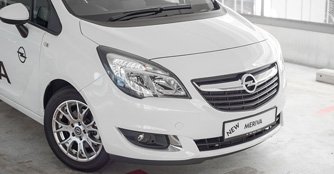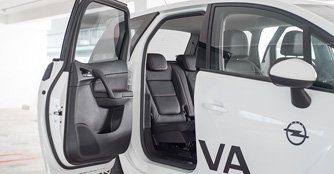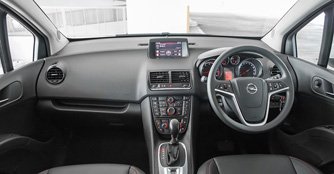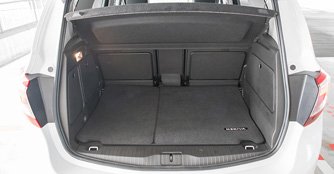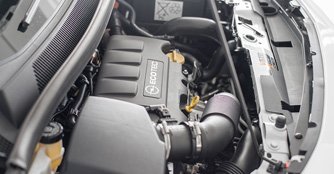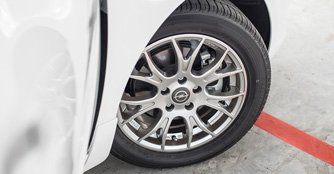Opel Meriva 1.4 Turbo (A) Review
17 Apr 2015|23,650 views
Standing out in the compact multi-purpose vehicle (MPV) market is tough, with names such as the BMW 2 Series Active Tourer, the Citroen C4 Picasso, the Mercedes-Benz B-Class and the Volkswagen Golf Sportsvan.
But the latest iteration of the Opel Meriva looks set to do so with its rearward-opening doors, akin to the coach doors on a Rolls-Royce.
The Meriva was conceived as a car for a young family, or maybe a second family car to replace the wife's supermini. The second generation of the compact MPV debuted globally in 2010 but it was only recently that the facelifted version arrived in Singapore.
Exterior
When viewed from a distance, the Meriva may resemble its siblings, the Astra and the Zafira Tourer. But take a step closer and you will realise that the design of the Meriva is unique in its own way.
With its small footprint - it's actually 119mm shorter than the Astra - it can replace a small hatchback, while being much more adept at hauling children and your barang barang.
 |
The new Meriva has adopted a more expressive and dynamic silhouette to its basic cab-forward MPV design. Like the Astra and the Insignia, a 'blade' on the side complements the window line with a distinct 'wave' accentuating the FlexDoors, and this does a good job of breaking up the car's boxy stance.
The styling, which needed little in the way of updating, remains as it was with staggered side windows, giving rear seat passengers more glass area.
Changes to the second generation Meriva are subtle but there's a new grille, flanked by redesigned 'eagle-eye' head lights, and chrome accents now frame the fog lights set in the front bumper.
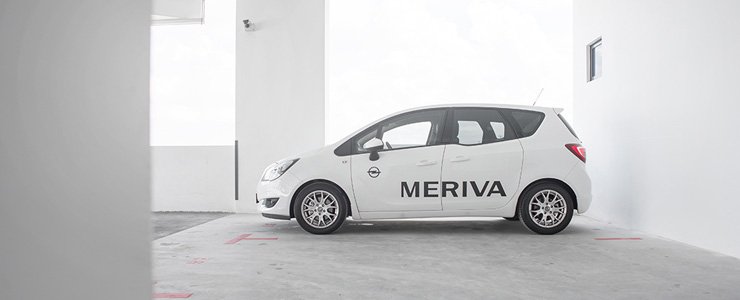 |
Interior
Opel has probably assumed that people who buy a compact MPV require not just a lot of interior space but particularly easy access to that space.
For that reason, the Meriva's doors open to a generous 84-degree angle, and those at the back are rear-hinged, which makes it easier to attend to the needs of children or to facilitate ingress/egress.
However, while FlexDoor is a clever and effective system, some people may prefer the sliding rear door arrangement of other MPVs in otherwise tight parking spaces.
The doors open up to comfortable seats that give good support and can also be moved back and forth individually, allowing for a range of configurations for seating arrangement.
Leaving the seats in default reveals a 397-litre cargo area that can be expanded to 1,496 litres with the rear seats folded down flat.
The cabin benefits from an upmarket look and feel. Decent quality plastics are used throughout, with excellent fit and finish. But while the dashboard is sleekly designed, the centre console, like most Opels, is cluttered with a slightly confusing array of buttons.
Another highlight in the Meriva is FlexRail, an extended centre console with various storage compartments that can be slid forward and backward, offering generous and flexible space between the front seats without compromising legroom for the middle rear passenger.
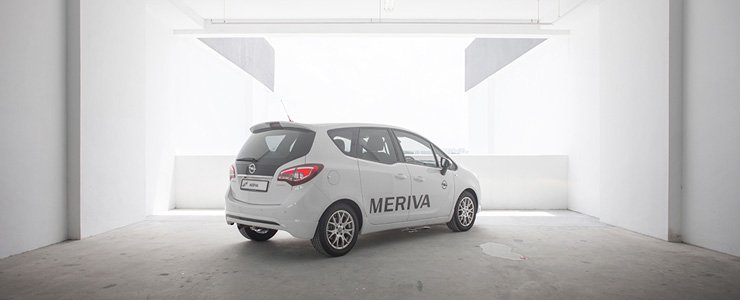 |
The Drive
The 1.4-litre turbocharged engine under the hood of the Meriva is refined at cruising speeds, but it needs to be worked a little hard to make the most of its performance.
Even so, the car feels relatively quick and enjoyable, taking 11.9 seconds to hit the century mark, 2.4 seconds faster than its predecessor that was equipped with a 1.6-litre naturally aspirated lump.
The standard six-speed automatic transmission is well-geared and this assists in better fuel economy, although we fell short of the claimed 13.9km/L and achieved only 10km/L during our time with the car.
On the go, the Meriva handles decently but not excitingly as the steering could do with better feel and weight. This is, nonetheless, entirely reasonable, given the car's target audience. More relevantly, when it comes to comfort, the MPV doesn't lean excessively when driving around corners despite its taller height.
Its ride is reasonably gracious too, with supple suspension soaking up bumps easily and making long journeys a breeze. In short, the Meriva is certainly a relaxing and easy car to drive, while good all-round visibility makes it an easy car to live with in everyday urban driving conditions.
Conclusion
Despite the subtlety of its styling updates, the Meriva looks a lot more upmarket than it did before. Coupled with the fact that it is one of the few compact MPVs that carries the Cat A COE, it should be able to stand out among its rivals, especially with those unique rear doors.
Standing out in the compact multi-purpose vehicle (MPV) market is tough, with names such as the BMW 2 Series Active Tourer, the Citroen C4 Picasso, the Mercedes-Benz B-Class and the Volkswagen Golf Sportsvan.
But the latest iteration of the Opel Meriva looks set to do so with its rearward-opening doors, akin to the coach doors on a Rolls-Royce.
The Meriva was conceived as a car for a young family, or maybe a second family car to replace the wife's supermini. The second generation of the compact MPV debuted globally in 2010 but it was only recently that the facelifted version arrived in Singapore.
Exterior
When viewed from a distance, the Meriva may resemble its siblings, the Astra and the Zafira Tourer. But take a step closer and you will realise that the design of the Meriva is unique in its own way.
With its small footprint - it's actually 119mm shorter than the Astra - it can replace a small hatchback, while being much more adept at hauling children and your barang barang.
The new Meriva has adopted a more expressive and dynamic silhouette to its basic cab-forward MPV design. Like the Astra and the Insignia, a 'blade' on the side complements the window line with a distinct 'wave' accentuating the FlexDoors, and this does a good job of breaking up the car's boxy stance.
The styling, which needed little in the way of updating, remains as it was with staggered side windows, giving rear seat passengers more glass area.
Changes to the second generation Meriva are subtle but there's a new grille, flanked by redesigned 'eagle-eye' head lights, and chrome accents now frame the fog lights set in the front bumper.
Interior
Opel has probably assumed that people who buy a compact MPV require not just a lot of interior space but particularly easy access to that space.
For that reason, the Meriva's doors open to a generous 84-degree angle, and those at the back are rear-hinged, which makes it easier to attend to the needs of children or to facilitate ingress/egress.
However, while FlexDoor is a clever and effective system, some people may prefer the sliding rear door arrangement of other MPVs in otherwise tight parking spaces.
The doors open up to comfortable seats that give good support and can also be moved back and forth individually, allowing for a range of configurations for seating arrangement.
Opel has probably assumed that people who buy a compact MPV require not just a lot of interior space but particularly easy access to that space.
For that reason, the Meriva's doors open to a generous 84-degree angle, and those at the back are rear-hinged, which makes it easier to attend to the needs of children or to facilitate ingress/egress.
However, while FlexDoor is a clever and effective system, some people may prefer the sliding rear door arrangement of other MPVs in otherwise tight parking spaces.
The doors open up to comfortable seats that give good support and can also be moved back and forth individually, allowing for a range of configurations for seating arrangement.
Leaving the seats in default reveals a 397-litre cargo area that can be expanded to 1,496 litres with the rear seats folded down flat.
The cabin benefits from an upmarket look and feel. Decent quality plastics are used throughout, with excellent fit and finish. But while the dashboard is sleekly designed, the centre console, like most Opels, is cluttered with a slightly confusing array of buttons.
Another highlight in the Meriva is FlexRail, an extended centre console with various storage compartments that can be slid forward and backward, offering generous and flexible space between the front seats without compromising legroom for the middle rear passenger.
The Drive
The 1.4-litre turbocharged engine under the hood of the Meriva is refined at cruising speeds, but it needs to be worked a little hard to make the most of its performance.
Even so, the car feels relatively quick and enjoyable, taking 11.9 seconds to hit the century mark, 2.4 seconds faster than its predecessor that was equipped with a 1.6-litre naturally aspirated lump.
The standard six-speed automatic transmission is well-geared and this assists in better fuel economy, although we fell short of the claimed 13.9km/L and achieved only 10km/L during our time with the car.
On the go, the Meriva handles decently but not excitingly as the steering could do with better feel and weight. This is, nonetheless, entirely reasonable, given the car's target audience. More relevantly, when it comes to comfort, the MPV doesn't lean excessively when driving around corners despite its taller height.
The 1.4-litre turbocharged engine under the hood of the Meriva is refined at cruising speeds, but it needs to be worked a little hard to make the most of its performance.
Even so, the car feels relatively quick and enjoyable, taking 11.9 seconds to hit the century mark, 2.4 seconds faster than its predecessor that was equipped with a 1.6-litre naturally aspirated lump.
The standard six-speed automatic transmission is well-geared and this assists in better fuel economy, although we fell short of the claimed 13.9km/L and achieved only 10km/L during our time with the car.
On the go, the Meriva handles decently but not excitingly as the steering could do with better feel and weight. This is, nonetheless, entirely reasonable, given the car's target audience. More relevantly, when it comes to comfort, the MPV doesn't lean excessively when driving around corners despite its taller height.
Its ride is reasonably gracious too, with supple suspension soaking up bumps easily and making long journeys a breeze. In short, the Meriva is certainly a relaxing and easy car to drive, while good all-round visibility makes it an easy car to live with in everyday urban driving conditions.
Conclusion
Despite the subtlety of its styling updates, the Meriva looks a lot more upmarket than it did before. Coupled with the fact that it is one of the few compact MPVs that carries the Cat A COE, it should be able to stand out among its rivals, especially with those unique rear doors.
Car Information
Opel Meriva 1.4 Turbo (A)
CAT A|Petrol|13.9km/L
Horsepower
88kW (118 bhp)
Torque
200 Nm
Acceleration
11.9sec (0-100km /hr)
This model is no longer being sold by local distributor
All Used Opel MerivaThank You For Your Subscription.



















